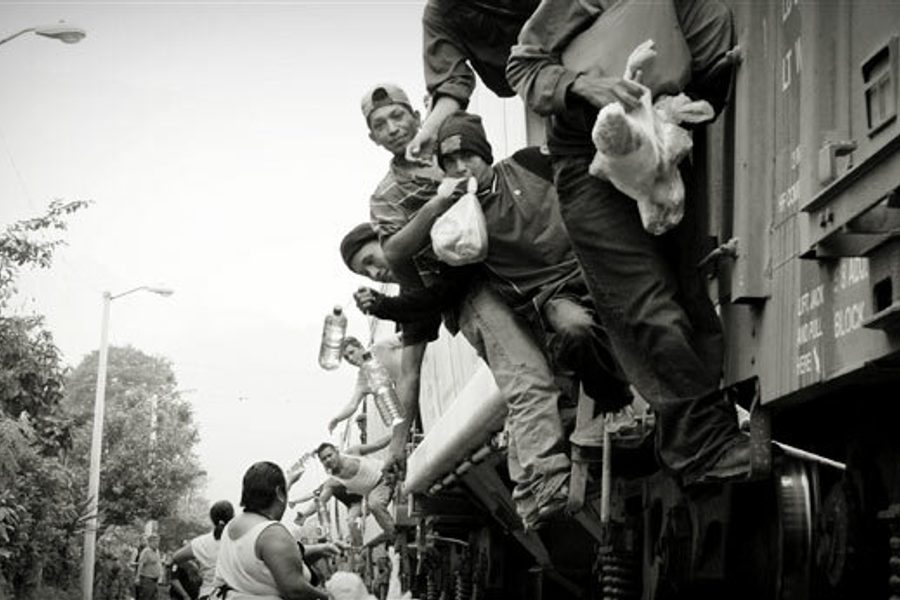The Patrons of Veracruz
The women of La Patrona provide sustenance for migrants making a wearying train-top journey across Mexico.
Joseph Sorrentino

One day in February 1995, two sisters — Bernarda and Rosa Romero Vázquez — were standing at a train crossing on their way home from buying bread and milk for breakfast in La Patrona, Mexico, waiting for the train to pass.
That train, like many passing through this small village in Veracruz, had people riding on top of and between the train cars — people who, the sisters later learned, were migrants from Central America making their way north to find work. Rosa recalls that as the train sped past one of the men on the first car called out, “Madre, we’re hungry.” The same thing happened when the second car passed. When a shout went up from people on the third car, the sisters tossed them the food they had just bought.
When they got home, they told their mother, Leonila Vázquez Alvizar, what had happened, and the family met and decided to start handing out food and water to the migrants, as they’ve done nearly every day since. Over the past 17 years, the group has grown, eventually becoming known as Las Patronas.
It’s estimated that hundreds of thousands of migrants pass through Mexico annually, most coming from Guatemala, Honduras or El Salvador. Although some will look for work in Mexico, most are hoping to make it to the U.S. The migrants typically cross the Mexican border into Tapachula, Chiapas. From there, they make their way by bus or on foot to Arriaga, where they’ll board a cargo train and begin their journey through Mexico. The trains the migrants ride are known collectively as “La Bestia,” The Beast. They’re aptly named. Migrants are subjected to all kinds of weather — heat, rain and, in the winter and spring, cold nights — as they sit on train cars, dressed in clothing that’s rarely adequate. Almost everyone has a backpack in which they carry some supplies, but they’ll go through them quickly. Falling asleep is dangerous because that’s when a person can roll off the train. Many have been injured and died from falls.
There are other dangers as well. Mexico’s Commission on Human Rights reported that there were 210 mass kidnappings between April and September 2010, involving 11,333 migrants. It’s been estimated that 60 percent of the women will be raped. Most of these crimes are perpetrated by drug gangs (kidnappings typically net them between $1,500 and $2,500), but local thugs, train crews and even police sometimes do too. Las Patronas knew nothing about this when they started. They just saw hungry and thirsty people.
La Patrona is about a 20 minute ride from Córdoba, the nearest city. The village’s name refers to the Virgin Mary. The main cash crop in the village is sugar cane, and most of the residents are involved with growing it (if they own land) or harvesting it (if they don’t). Trucks laden with sugar cane rumble through the streets all day and well into the night, filling the air with dust and gasoline fumes. There’s no other industry in La Patrona and, as in most small villages in Mexico, people struggle to get by.
When Las Patronas first started handing out food and water, it was strictly a family affair, with Leonila working with her four daughters — Norma, Bernarda, Rosa and Maria Antonia. The women bought all the food and cooked it in their individual homes. There are 15 women in the group — a couple of sisters-in-law, some nieces and a few friends. Other women — and occasionally some men — will volunteer for a few days or sometimes as long as a couple of months. Now, much of the food is donated, and Las Patronas work together in a large kitchen located on land donated by Crisoforo Romero Arragan, the family patriarch. A typical day for Las Patronas begins around 9:30 in the morning, with the women first heating up water to cook the 22 pounds of rice and beans they’ll need that day. The group keeps up a constant chatter during the day, joking and teasing one another.
There’s no telling when a train will pass or how many will pass by in a day. Sometimes the women will get a phone call from a friend who lives a short distance away, letting them know a train is arriving, but most times the only signal is the sound of a distant whistle. When someone hears a whistle from a north-bound train, there are shouts of “Viene tren!” (“The train is coming!”), and the women scramble to grab cartons laden with food and quickly push wheelbarrows filled with water bottles to the tracks, about 150 feet away. The women spread out, food and water at their feet, and wait for the train.
When the trains blow past it’s an intense, adrenaline-pumping time. The women stand a couple of feet away, their arms extended, dangling food or water. Dozens of migrants cling to the train with one hand while stretching out to grab supplies. They shout and whistle and the women respond in-kind. Migrants snatch the supplies, many shouting, “Gracias, madre.” Train wheels screech, adding to the cacophony. Bags of food or water are sometimes dropped, exploding on the ground near the train. And then, in about two minutes, it’s over, and the women, panting, return to the kitchen to prepare food for the next train.
At night, trains often slow down to make it easier for the migrants to grab food. One night in February, a train slowed down and then stopped on the crossing. As many as 600 migrants poured off and surrounded the women, quickly exhausting the food and water they had prepared. Toward the back of that train, riding alone between two cars, was José Luís, a scared looking 11-year-old boy from Honduras. He said he was traveling with his brother, but when asked where his brother was, he just waved toward the front of the train. It was a cool night and José Luís was dressed in only a T-shirt, shorts and sandals. Someone gave him a hoodie.
He said that he was on his way to the United States. “There is no work in Honduras,” he said, “and I must help my mother.” Las Patronas have seen much pain and suffering in the 17 years they have been doing this work, but the night the train stopped and they met José Luís, left them all shocked.
A couple of nights later, a train stopped a few miles from the site where Las Patronas typically hand out food. The women and the volunteers climbed into pickup trucks and sped through the village to meet it. The women like it when trains stop, as it gives them a chance to talk with migrants, to wish them luck and to receive their thanks. And the migrants can relax just a bit, sipping a soda in relative comfort.
The work Las Patronas do is physically and emotionally taxing. The women are no longer content with just handing out food and water and have become involved in the larger issue of migrant rights. Adjacent to the kitchen, they’ve built a small clinic to treat the sick and injured. A second building can house a few migrants in need of a rest. And they’re in close contact with organizations that provide shelter for migrants across Mexico, and lobby the Mexican government to do more to protect them. Las Patronas sometimes wonder if the donations and volunteers will give out. But they themselves have no doubt they’ll continue. “While God gives me life, and migration continues to exist,” says Norma, “I believe I will be here helping.”








